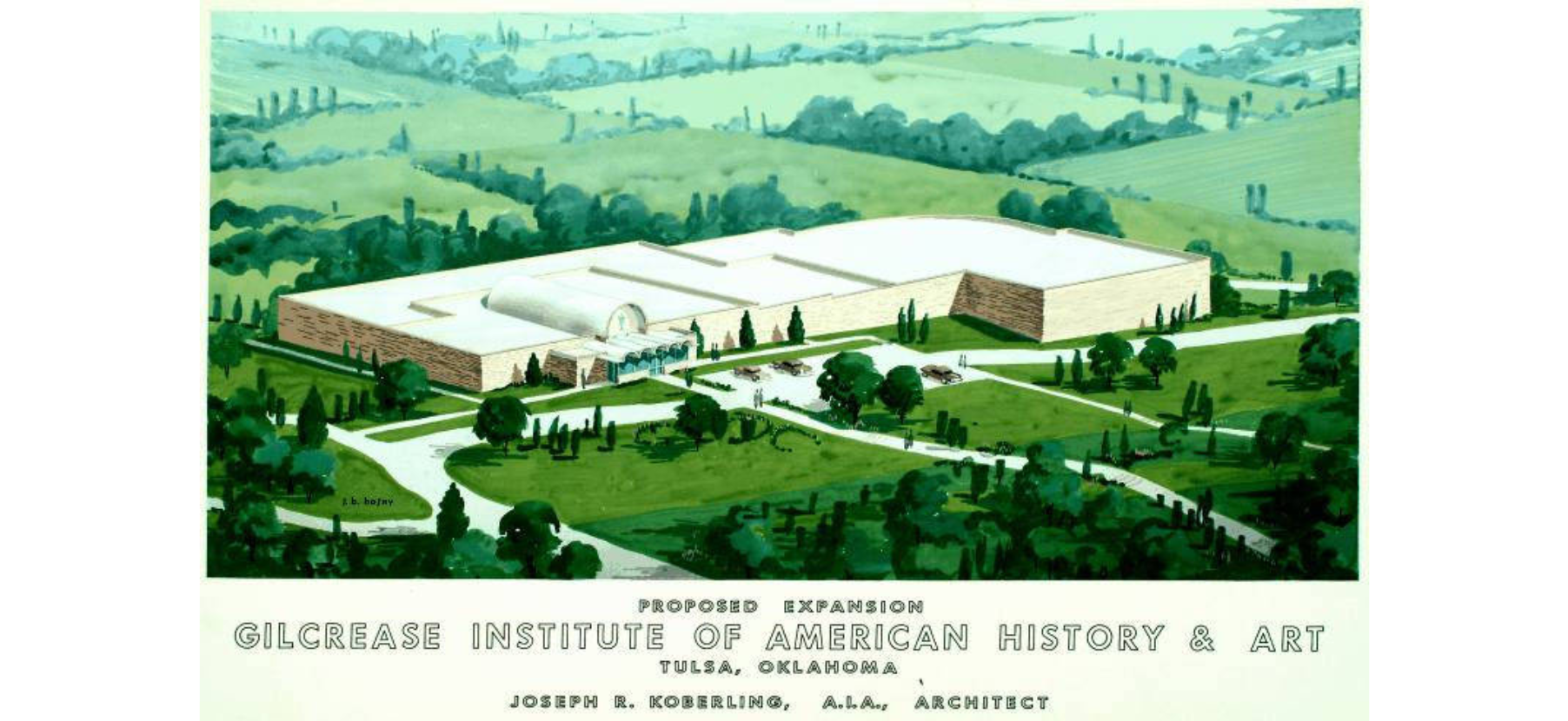June 2021 Archives
You have five more days (Wednesday, June 30, 2021, to Sunday, July 4, 2021) to visit Tulsa's Gilcrease Museum before the museum, as you've known it for the last 57 years, goes away forever. The museum is open from 11 a.m. to 4 p.m. every day, with extended hours to 8 p.m. on Thursday. You can book online. The museum is being demolished and replaced, the result of a bait-and-switch with Tulsa voters, who had approved funds for museum expansion.
The City had promised renovating 64,000 square feet of the museum and adding 20,000 square feet of new construction. Here's a video, preceding the 2016 Vision Tulsa vote, showing a floor plan for an expanded museum, with a new entrance, gift shop, and an upward expansion to make the museum visible from downtown.
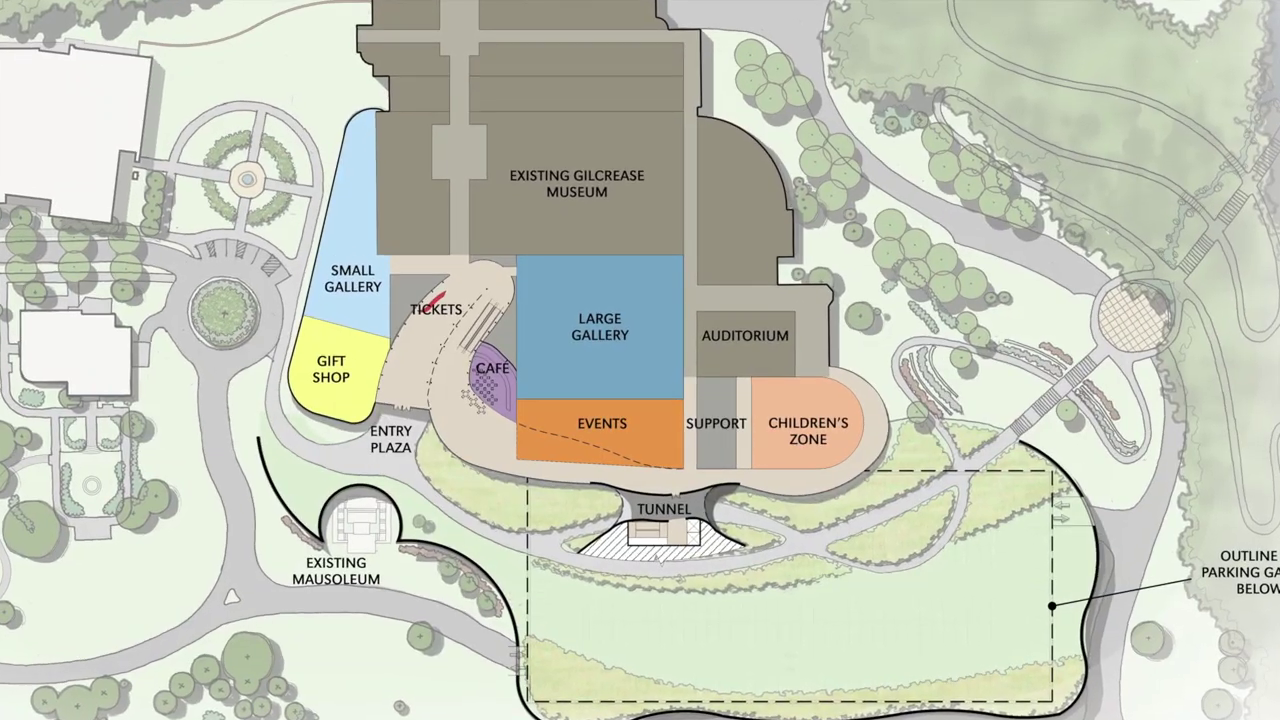
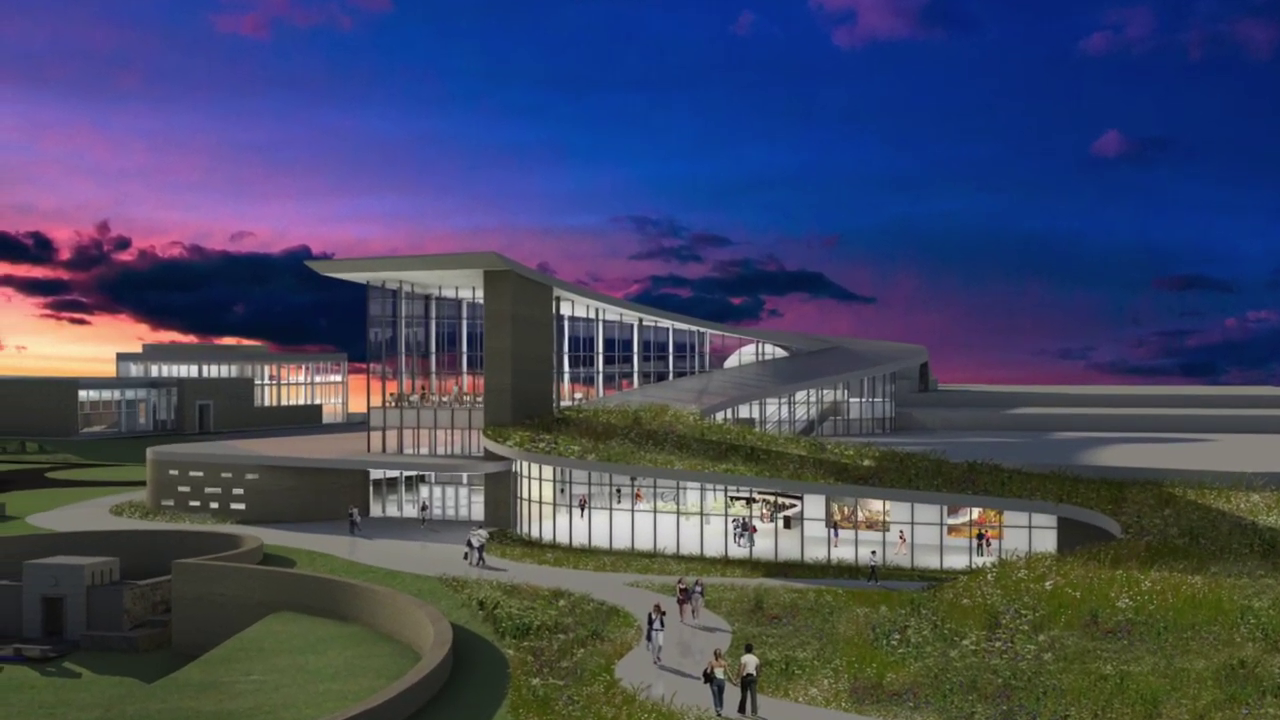 Floor plan and conceptual drawing of Gilcrease Museum expansion as proposed prior to the 2016 Vision Tulsa sales tax vote
Floor plan and conceptual drawing of Gilcrease Museum expansion as proposed prior to the 2016 Vision Tulsa sales tax voteThe change in plans was substantial enough to require public notice and City Council amendment of the Brown Ordinance governing the sales tax funds. The existing 134,000 sq. ft. building is being replaced with an 83,500 sq. ft. facility.
At 83,500 square feet, the new Gilcrease Museum will be markedly smaller than the existing one, a 134,000-square-foot structure built as a 1913 carriage house and subject to numerous expansions over the decades.
Note that this number is even smaller than reported when the demolition plan was first revealed.
While proponents claim, "By being thoughtful about the design, the 89,000-square-foot facility will have more exhibition space than the current 134,000-square-foot structure," I expect to learn, when the new building opens, that they tried and tried, but could not produce the added exhibition space within the constraints of the budget.
This past weekend, conceptual drawings of the new facility were released: A characterless glass box, surrounded by unshaded outdoor plazas. The Gilcrease Vision Task Force, appointed by Mayor G. T. Bynum IV, chose the firms redesigning the museum; I have so far been unable to locate a list of the members of this task force.
We had a rushed visit on Sunday afternoon, with plans to return one more time this week. Gilcrease Museum holds many happy memories for our family, like the 2006 city inauguration, which we attended with our brand new baby boy, celebrating the swearing-in of John Eagleton, Rick Westcott, and Maria Barnes; or special exhibits like Ansel Adams (2009), George Washington (2012), Thomas Moran, Norman Rockwell, and Dorothea Lange. For many years, Gilcrease hosted Santa Claus (aka my dad) for a special seasonal Funday Sunday; for our family, it was a chance for a family Christmas photo and to reacquaint ourselves with the masterpieces on display.
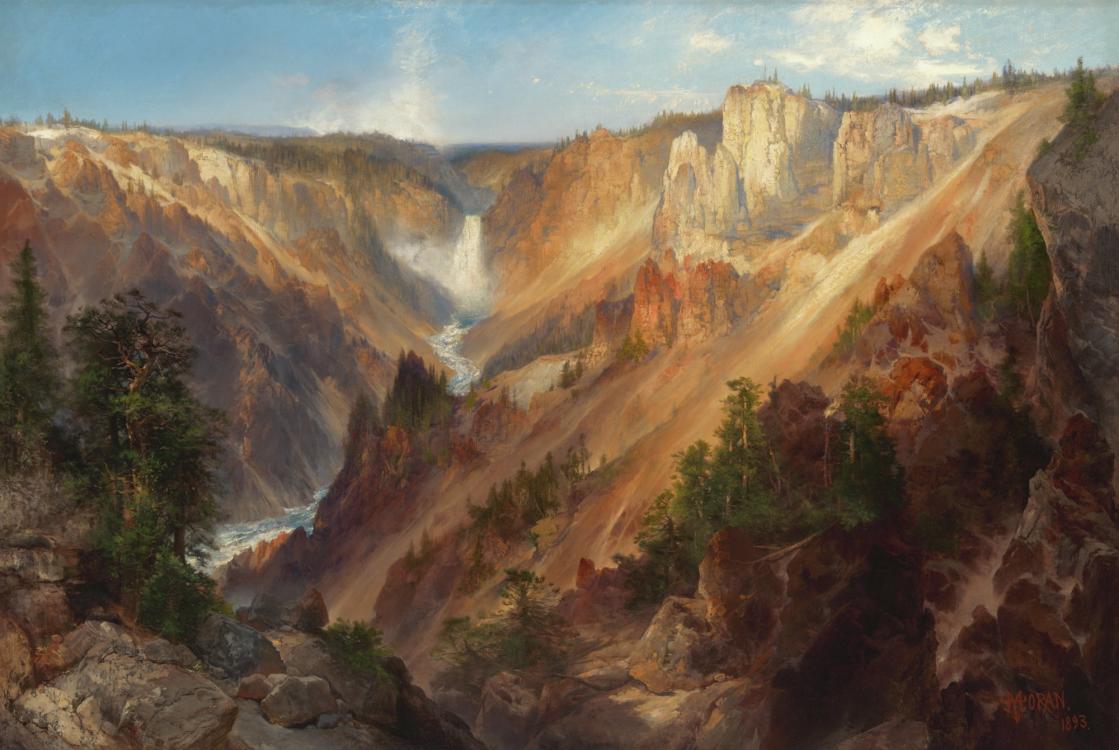
During our visit this past Sunday, several galleries were off-limits, including the gallery on the southwest corner of the building and the traveling exhibition gallery. The recreated artist's studio is gone. The large gallery that was once dedicated to paintings of the American West is now called "Americans All! / Americanos Todos!" devoted to art by immigrants. This gallery, uniquely in the museum, has captions in both English and Spanish. It includes works by great artists of the American West who once had dedicated galleries at Gilcrease -- Thomas Moran (from England), O. C. Seltzer (from Denmark), and Albert Bierstadt (from Germany) -- but it also includes works of less significance (to be kind) by more recent immigrants. Included in this latter category is a selfie-video of a young Mexican woman, Carmen Castorena, who was allowed to stay in the US under Obama's DACA program.
The Perfect Tommy Girl by Carmen CastorenaThis performance piece examines my alteration process in becoming the ultimate American me. The setting is my bathroom. As I see my reflection and "operate" on myself through multiple bleaching procedures, lightening of my eyebrows, removal of facial hair, and changing the color of my eyes, I eat a bowl of fresh cacti. The phrase, "Nopal En La Frente (Cactus on Your Forehead)," is used to mock those who go around pretending they are not Mexican. The consumption of this native plant is a way to communicate that no matter what physical procedures you may undergo, a Mexican can never fool anybody into thinking they aren't Mexican. There is a battle between the exterior (seeing the physical changes) and interior (processing those changes) that forms the focal point of the performance. This video is my way of channeling years of alienation and reaching closure in the creation of my "ideal self."
(It's useful to know that attempts at trans-ethnic transformation are futile. The notion is applicable to other situations: "No matter what physical procedures you may undergo, a [male] can never fool anybody into thinking [he] [is]n't [male].")
A room of the gallery that might have been used to display more of the beautiful landscapes and Native American art stored in the vaults was instead used for two walls of editorial cartoons -- one by Bruce Plante, one by Thomas Nast -- advocating for unrestricted immigration -- and two walls with infographics designed to push the same political line.
This should be seen as a preview of the reborn Gilcrease Museum: The great works depicting the vast frontier of the American West will be displayed only to the extent needed to support new works that push a political message. The mingling of old and new is an effective strategy: We certainly would not have bothered with the exhibit except for the presence of iconic Gilcrease works by artists like Moran, Bierstadt, Seltzer, John James Audubon, and Augustus Saint Gaudens.
Want more evidence of the downgrade? Here's a video from Gilcrease Museum Senior Curator Laura Fry, speculating that painter Alfred Jacob Miller, his patron William Drummond Stewart, a Scottish nobleman and veteran of the Battle of Waterloo, and Antoine Clement, a French / Cree buffalo hunter, engaged in homosexual acts with one another, based on Miller never marrying and the friendship between the three men. Stewart had invited Miller to accompany him to the great trappers' rendezvous in 1837 in present-day Wyoming. Stewart commissioned Miller to paint scenes of the American West to decorate Murthly Castle in Dunkeld, Scotland. Clement was principal hunter of Stewart's traveling party. According to her LinkedIn profile, Fry was a member of the Mayor's Gilcrease Vision Task Force which authorized the ugly new building. The Gilcrease YouTube channel includes more of this sort of nonsense, like a presentation on "Gender in Pre-Columbian Cultures and Native Communities Today," part of a November 2018 symposium on gender.
Museums are part of the overall kulturkampf of the Left, the Long March through the Institutions. I will be saddened but unsurprised if long-time favorites, landscapes and scenes of the American West from the core of Thomas Gilcrease's collection, are never returned from storage, for lack of space, you understand.
According to some accounts, Thomas Gilcrease founded his museum in San Antonio in 1942 and moved it to Tulsa in 1949. But an Associated Press story in the December 20, 1942, Daily Oklahoman says that the "San Antonio oil man's 80-acre [Tulsa] estate has not been occupied for several years" and was being transformed "into a museum and orphanage for Indian children... by a crew of carpenters and painters.... The institution will be supported by the Thomas Gilcrease Foundation. The oil man has donated valuable assets and his extensive collection of Indian relics to the foundation."
Part of the building is said to date back to 1913. Walls of rough-hewn sandstone block can still be seen on the north and south sides of the building where they haven't been enclosed or superseded by later additions.
The Thomas Gilcrease Institute of American History and Art was transferred to the City of Tulsa on January 27, 1955, after citizens approved a bond issue in August 1954 for $2.25 million to pay the debts of oilman Thomas Gilcrease, staving off the dispersal of his priceless collection of the art and artifacts of the American West. (This video by Fry describes the early history of the museum.) The bonds were repaid over time by revenues from Thomas Gilcrease's oil assets. While the original mid-50s concept for the Civic Center included a 42,600 sq. ft. facility for the Gilcrease collection, in 1958, the existing grounds and building, which had been leased from Thomas Gilcrease, were deeded to the city. In 1961, Tulsans voted a half-million dollar bond issue for a museum expansion that opened to the public on October 27, 1963, which added the Vista Room and a 250-seat auditorium, tripling the size of the museum and enabling 40% of the collection at that time to be put on display. At the grand opening, the Gilcrease Foundation announced it was donating to the City 10.5 acres of land and its collection of art and artifacts, valued at $5 million in 1963.
A museum map from that period shows the following galleries:
- Introductory to the Collections
- American Classics
- Remington Collection
- Russell Collection
- Taos Artist
- Seltzer - Leigh - Johnson
- Landscapes - Treaties - People
- Special Exhibit - Willard Stone Sculpture
- Thomas Moran
- George Catlin - Alfred Jacob Miller
- Artifacts
Gilcrease Museum expanded again in the 1980s, this time with $12.25 million in private funds, to add a gift shop, restaurant, and additional exhibit space, including Helmerich Hall with its double-barrel-vaulted ceiling as the new heart of the museum and space for a conservation laboratory and anthropological collections. The museum doubled in size to 127,786 sq. ft. The new space opened on November 7, 1987. During the 1980s, admission was free, and the museum was open weekdays 9 to 5 and 1 to 5 on Sundays. The City of Tulsa has since provided additional capital funding for improvements via "Third Penny" sales taxes and bond issues. In September 2014, the Helmerich Center for American Research opened its doors.
So go see Gilcrease before it is transformed into something expensively worse. And next election, replace Bynum IV and the City Council with officials who will insist that the City of Tulsa's Gilcrease collection of art be curated and displayed to celebrate the American West, in the spirit of the oil man who brought it together and gave it to us.

This past Saturday morning, after visiting the Greenwood Farmers and Artisans Market, I took some photos of the old Moton (Morton) Health Center complex just west of Rudisill Library, on the north side of Pine Street between Greenwood Avenue and Greenwood Place. According to the cornerstone, the original three-story, blond brick building dates to 1931 and was a municipal hospital. Charles Adrian Popkin was the architect; DeWitt and Howard were the contractors.

Sometime in the 1970s or 1980s (my guess, based on the style), an ugly extension was grafted on to the front of the building, and single-story outbuildings were constructed for additional clinic space. These outbuildings have signs labeling them as clinics for pediatrics, OB/GYN, nutrition, WIC, and dentistry. The roof of the historic building appears to be gone, at least partially. It appears to have been boarded up for at least a decade. Urban explorer David Linde has a photoset of the interior of Morton Health Center on Abandoned Oklahoma. The additions appear to have compromised the integrity of the historic building.

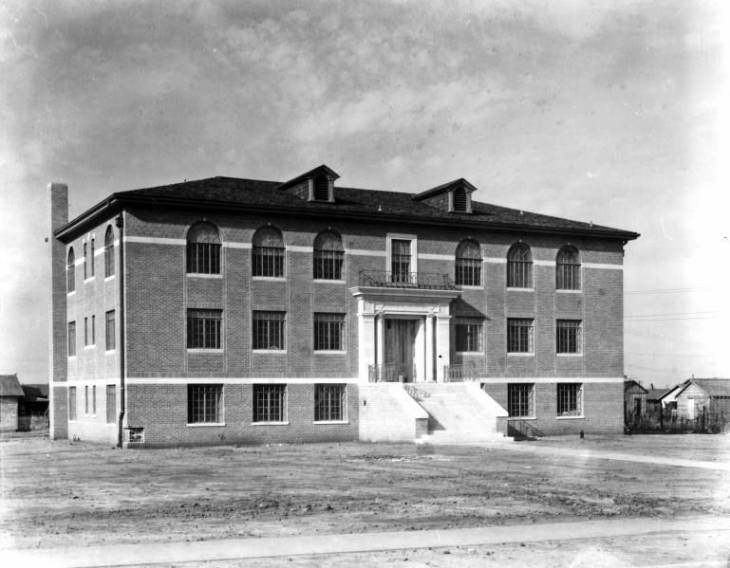 Tulsa Municipal Hospital (later known as Moton Memorial Hospital), 1931. The Beryl Ford Collection/Rotary Club of Tulsa, Tulsa City-County Library and Tulsa Historical Society. Accession # C1906.
Tulsa Municipal Hospital (later known as Moton Memorial Hospital), 1931. The Beryl Ford Collection/Rotary Club of Tulsa, Tulsa City-County Library and Tulsa Historical Society. Accession # C1906.The building was a hospital from 1932 to 1967, and was turned over by the city to a community board in 1941, when it was named Moton Memorial Hospital in honor of Robert Russa Moton, who had succeeded Booker T. Washington as president of the Tuskegee Institute.
In 1938, the Interracial Committee of the YWCA issued a "Study of the Conditions Among the Negro Population of Tulsa." The first page was devoted to medical care:
There is one hospital in North Tulsa located at 603 E. Pine St: Municipal Hospital.Equipment: 32 beds, but no beds for children. Condition of equipment: Inadequate.
Staff of hospital: 1 doctor, 4 nurses, 2 orderlies, 1 janitor, 1 cook. Nurses work an eight hour day and for $65 per month.
Charges to patients: None to charity cases. In ward: $17.50 per week. $20 per week for private room.
Hospital is maintained by the County. "A" rating in the small hospital class.
Other hospitals in Tulsa to which negroes are admitted:
Charges in above: Charity cases, none.
- St. John's Hospital at 21st and S. Utica: 13 beds
- Tulsa General at 744 W. 9th: 6 beds
$17.50 per week in ward and $25 per week in private room.
The report goes on to note that an outpatient and general clinic was "held daily, with no charge to the patient" at the hospital, "maintained by the County and is staffed by the regular staff of the hospital." The Public Health Association maintained weekly clinics for tuberculosis, child welfare, "immunizating," and prenatal care at 509 E. Archer Street, provided by a public health nurse and attending physician at no cost to the patient, maintained by Community Fund. For venereal diseases, the Public Health Association worked with patients at the Municipal Hospital. Crippled children were helped at a clinic at the YWCA at 621 E. Oklahoma Place, maintained by the Crippled Children's Society.
An item in the February 20, 1942, edition of the Tulsa Herald All-Church Press announced that the Women's Society (W.S.C.S.) of the First Methodist Church was donating 51 full-size sheets and three "draw sheets" to Moton Memorial Hospital, "Tulsa's hospital for negroes." That summer, incumbent Tulsa County District 3 Commissioner Ralsa F. Morley, running for re-election, wanted voters to know that he stood for the Tulsa County Clinic, Moton Hospital, and "All Out for Victory for America." In the spring of 1957, Moton, Hillcrest, and St. John's hospitals were to hold a week-long clinic to administer the first of three doses for the new Salk polio vaccine.
In 1967, Moton Memorial Hospital was closed and the facility reopened the following year as an ambulatory (outpatient) clinic.
A Model Cities (urban renewal) project report from January 1971 mentions a planned $2.25 million expansion that would "double the Clinic's Current capabilities." This is presumably the source of the ugly 1970s additions.
The Morton website says, "In 1983, and as required by BHC, the center was renamed. The name chosen was Morton Comprehensive Health Service in honor of W. A. Morton, M.D., a local physician with a distinguished record of service at Moton Memorial Hospital."
In 2006, Morton Comprehensive Health Services moved from this facility to a new building at 1334 N. Lansing, on the site of a neighborhood that was cleared by the Tulsa Development Authority to create an industrial park.
It would be lovely to see the ugly additions cleared away, the 1931 building restored, and the empty space around it filled with new development in a traditional urban style, with street-fronting retail and offices or apartments above.
In 2013, the city used brownfield remediation grants to remove asbestos and other hazards from the main hospital building. In 2017, a Houston developer named Michael Smith won TDA approval for Morton's Reserve, a project that would restore the 1931 building, construct a three-story mixed-use building around it, with a four-story apartment building to the north. Smith & Company Architects from Stafford, Texas, developed the site plan. But after a flurry of PR in 2017, nothing more seems to have happened.
In May 2021, Mayor G. T. Bynum IV announced that the old hospital will become an entrepreneurship incubator called Greenwood Entrepreneurship Incubator @ Moton (GEIM). No timetable is mentioned for restoring the building, but the post mentions the Morton's Reserve project, and in the meantime, a program called MORTAR Tulsa will provide mentorship and training for for-profit entrepreneurs.
MORE: On May 6, 1980, Cheri Poyas with the Junior League of Tulsa interviewed physician and surgeon Dr. Charles Bate, who came to Tulsa in 1940 and did much of his early work at Moton. He recalls that Moton had a rope elevator, no laboratory facilities, and a poor-quality X-ray machine. He recounts the special challenges of anesthesia, home births, treating tuberculosis, venereal disease, and small pox, and doing blood pressure screenings.
UPDATE 2021/09/06: A story in Tulsa People says that the redevelopment project will happen, but now the Moton building rehab will be funded and managed by Tulsa Economic Development Corporation, separate from the new development, which still involves Michael E. Smith, a Tulsa native now living in Houston.
"The hospital building sits on a 3.83-acre tract of land," he explains, "and I'm doing everything outside of the hospital building."This project will bring another level of single-family homes into the area -- 12-16 really nice East Coast-style, vertical three-story townhomes -- and then 64 units of multi-family," Smith continues. The whole complex, a $20 million project, will be called Morton's Reserve.
Both organizations plan to start project design later this year.
We shall see.

POST-ELECTION UPDATE: While the winning percentage was lower than 2015, it was still 3-to-1 in favor. Turnout was only 17,599, a tiny increase over the 17,125 that voted in March 2015. That's about 11.5%. Most organizations require a quorum of the membership to be present to take any action; why shouldn't we require a quorum of 50% of eligible voters to cast a ballot in order for a proposition to be enacted into law?
The two municipal propositions in Lahoma and Spavinaw were franchise renewals for OG+E and PSO, respectively, and passed unanimously. Navajo Public Schools bond issue passed by 5 votes.
There's yet another election this Tuesday, June 8, 2021. The Tulsa Public School board scheduled a special election for four general obligation bond issue propositions totaling $414 million. TPS residents can express their lack of confidence in the TPS administration's stewardship of our tax dollars and our children's education by voting NO on all four propositions. Opponents of the bond issue will hold an Accountability Matters Rally Opposing TPS School Bond at 5:30 pm, Monday, June 7, 2021, at the Education Service Center, 3027 S. New Haven Ave.
Never mind that we had an annual school general election back on April 6. TPS decided to hold the bond election at a time when nothing else would be on the ballot, when most Oklahomans' minds would be on summer activities. In all of Oklahoma, only four places are having an election on June 8, 2021: The Town of Lahoma (Garfield County), the Town of Spavinaw (Mayes County), Navajo Public Schools (Jackson & Greer Counties), and Tulsa Public Schools, which requires four county election boards (Creek, Osage, Tulsa, Wagoner) to staff precincts.
A school bond issue requires a corresponding increase in property taxes in the district to repay the borrowed money. Even property owners (e.g., senior citizens) who enjoy a valuation freeze will see their taxes go up, because the bond issue increases the millage rate, not the valuation of the property.
Governmental taxing authorities like scheduling special elections, because it offers a great deal of control over who turns out to vote. School officials will be sure to remind teachers and administrative staff that there's an election, and they might target parents with an interest in a particular project slated to be funded by bond money. Otherwise they keep it as quiet as possible. There's unlikely to be an organized campaign against the bonds, because concentrated benefits motivate funding for the "vote yes" side, while diffuse costs mean that opponents don't have as strong a motivation to contribute financially to its defeat. The last bond election in March 2015 drew only 17,125 voters. As of March 29, there were 152,453 eligible voters in the TPS district. Under Oklahoma law, school bond issues require approval of 60% of those voting.
But such an election also is an unusual opportunity for parents and taxpayers to issue a vote of no confidence in TPS leadership. School board elections are seemingly set up to defeat democracy. In most districts, it is only possible to replace one of the five board members every year. As a large district, TPS has a seven-member board and four year terms, but in either situation, there is no way to "throw the bums out," to clean house, to elect a new slate of board members that will take the district in a different direction. Making matters worse, filing period is held in early December when everyone is thinking about Christmas, and the school board elections are often the only item on the ballot during the February primary and April general election.
A school bond issue offers every voter in the district a chance to vote at the same time. It is the perfect opportunity to let the school board know that you're unhappy with the superintendent, the board, curriculum, the COVID-19 response, school closures, and the district's too-cozy relationship with progressive philanthropic organizations.
None of a school district's operational funds come from bond issues, so defeating a bond issue does not jeopardize teachers' salaries or the day-to-day running of the schools. Defeating a bond issue just means that TPS will have to wait a bit longer to build another monstrosity like the new Clinton West Elementary (formerly Clinton Middle School), which was James Howard Kunstler's "Eyesore of the Month" in March of 2010.
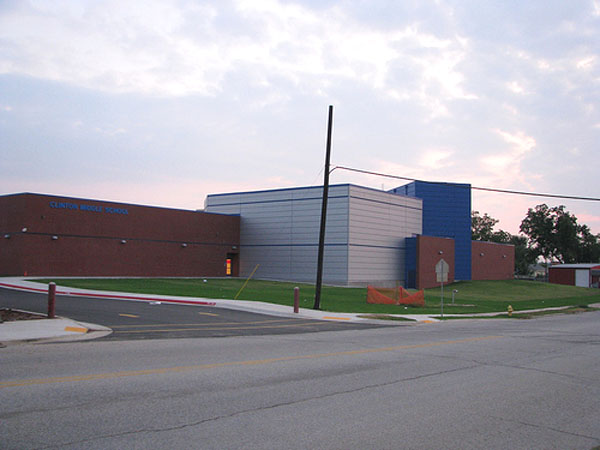 Clinton West Elementary (formerly Middle School), Eyesore of the Month, March 2010.
Clinton West Elementary (formerly Middle School), Eyesore of the Month, March 2010. James Howard Kunstler described the building as "a building that expresses to perfection our current social consensus about the meaning of education. It stares balefully at the street with the blank-faced demeanor of an autistic child preparing to explode in violent rage. It summarizes our collective aspirations about school as the unidentifiable contents of an inscrutable set of boxes."
This time around, there is an active campaign against the bond issue propositions. Both Tulsa Parent Voice and the Tulsa County Republican Party have announced their opposition to the bonds.
There are plenty of reasons that the administration and board of Tulsa Public Schools deserve a vote of no confidence. Here are just a few that come readily to mind:
1. Scheduling a bond issue election for the summer, when nothing else is on the ballot, is designed to discourage voter participation. A solid defeat of the bonds will discourage such anti-democratic behavior in the future.
2. TPS schools are failing. Out of 73 campuses receiving a State Department of Education report card in 2019, 57 received Ds or Fs (29 and 28, respectively). Only one school, Booker T. Washington High School, managed an A. (You can download grades and stats for every school in Oklahoma here.)
3. TPS is shrinking, but the demand for funds is unchanged. Since the 2015 bond, TPS enrollment has decreased by 6,500 students, but TPS is asking for as much as it did then, including money for new facilities. Ten schools that were promised 2015 bond money were closed instead: Jones, Park, Penn, Remington, Academy Central, Greeley, Grimes, ECDC Porter, Mark Twain & Gilcrease. Gilcrease was closed despite a petition signed by 2,500 residents.
3. The school board's 2020 decision to extend Superintendent Deborah Gist's contract through 2023 was timed to prevent newly elected school board members from participating in the decision, which shows profound disrespect for the voters.
4. TPS pushes progressive politics. Superintendent Gist's May 2021 personal statement about "equity" is filled with leftist jargon from the Critical Race Theory glossary, but the rot is by no means limited to Gist. The district's "Who We Are" page states that "living our values requires working actively to dismantle systems of racial oppression."
5. The information about the bond issue propositions on the TPS website is supportive marketing material, not neutral, just-the-facts information. This is in violation of state law.

6. TPS requires a formal request under the Open Records Act to release campaign contribution reports that, by state law, must be filed with the school district clerk. TPS does not respond to these requests in a timely fashion -- another anti-democratic policy.
7. TPS has a bloated administrative structure and spends millions on consultants.
8. TPS has continued to force children to wear masks and never returned to full-time in-person learning.
There are plenty of other reasons to revolt against the current TPS administration, many of which you'll see documented on the sos-tps.org website, which also has the specifics on the four propositions. A vote against the bond propositions is the simplest way to express a demand for change at Tulsa Public Schools.
